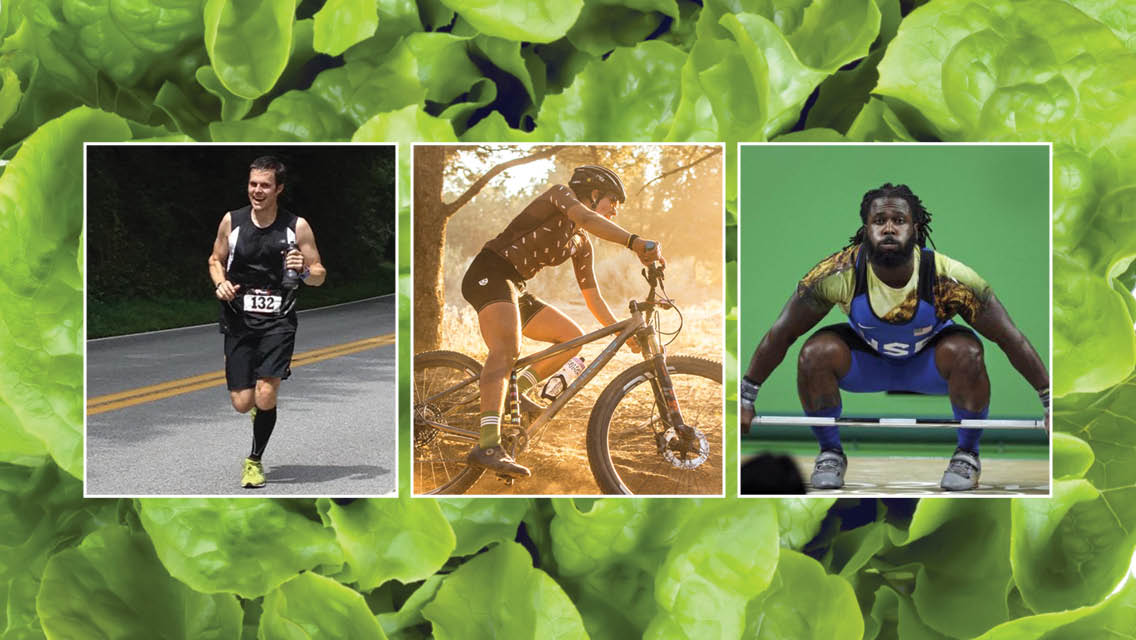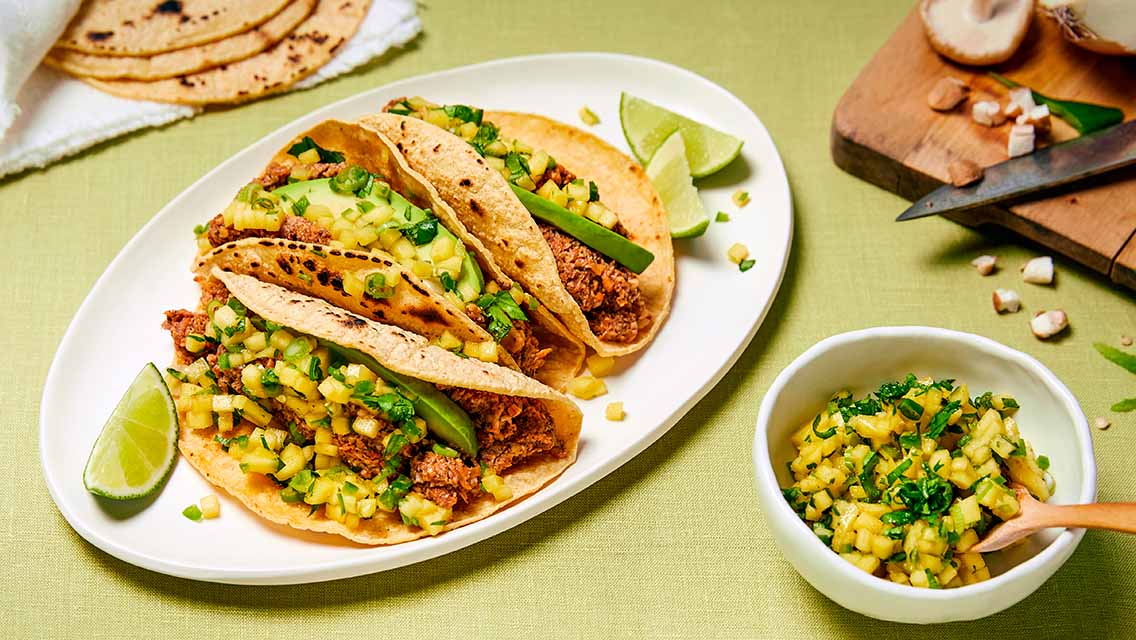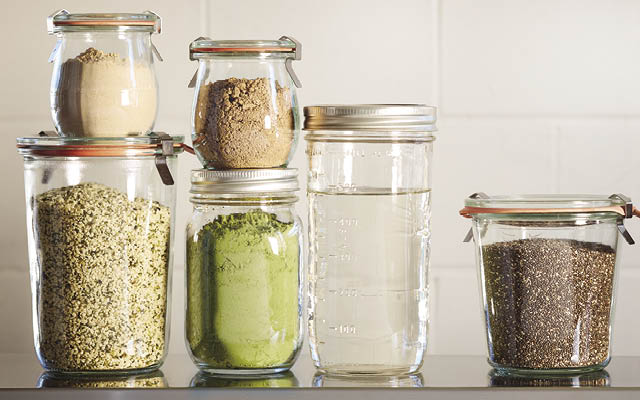We have long associated strength with protein, and protein with eating animal products. While Popeye touted building his biceps with spinach, the suspicion was that he had to be eating steak on the sly.
In recent years, however, elite and amateur athletes have proven they can perform at peak levels while fueling their training on a diet of predominantly — or in many cases, solely — plants. Tennis pro Venus Williams has eaten a mostly vegan diet since 2011, ultrarunner Scott Jurek regularly runs 100 miles without animal products to fuel him, and quarterback Tom Brady, at 43, is proving he can outsmart his age while eating mostly plant-based meals.
Olympic weightlifter Kendrick Farris also believes in the power of plants. Since 2014 he has thrived on a plant-based diet. He set a U.S. record after lifting a combined 831 pounds in the snatch and the clean and jerk during the 2016 Olympic Trials. He’s competed in three Olympic Games; if all goes well, he’ll be back for a fourth later this year.
Farris became interested in plant-based eating after discovering that his ancestors ate this way for most of the year, and he decided to change his diet to get back to what he considers a purer form of life. “I wasn’t concerned about my athletic performance: I thought that would take care of itself. I was more concerned with being healthy and being here for my family,” he explains.
The 34-year-old Olympian credits his nutrition practices for helping him sleep better, avoid injury, and recover faster.
Whether you are looking to ramp up your veggie intake or eliminate animal products altogether, embracing a plant-forward protocol doesn’t have to hinder your performance. In fact, if you choose whole foods, focus on a variety of plants, consume sufficient calories, and supplement as necessary, fueling with plants can benefit both your health and your fitness.
Learn how experts address nutritional needs on a plant-forward diet.
Prioritize Protein
“But what about protein?” It’s a question every plant-based athlete hears time and again.
While animal products provide an easy source, you can meet your protein needs with plant-based foods, says Asheville, N.C.–based marathoner and ultrarunner Matt Frazier, coauthor of The No Meat Athlete Cookbook.
“I think it’s largely a misconception that plant-based athletes are going to struggle with protein. If you’re eating whole foods, it’s not that hard to do. Even foods like veggies, fruit, rice, and pasta have some protein in them,” says Frazier. “If you talk to plant-based athletes, they’re typically getting 15 percent of their calories from protein.”
Protein needs vary depending on several factors, including your bioindividuality, your muscle mass, and how well you digest and absorb protein, says Paul Kriegler, RD, Life Time’s nutrition program manager. “If you’re doing any type of activity that includes more mechanical breakdown, such as resistance training, it’s likely your protein needs are higher than someone who is doing cardiovascular exercise.”
The International Sports Society of Nutrition (ISSN) recommends that athletes involved in moderate amounts of intense training consume 0.45 to 0.68 grams per pound of body weight daily — that’s about 67.5 to 102 grams of daily protein for a 150-pound person.
Meanwhile, athletes engaged in high-volume intense exercise, including strength training, are advised to up their intake to 0.68 to 0.9 grams, or up to 135 grams daily for a 150-pound person. Some studies have suggested that even higher protein intakes may enhance body composition in those who regularly do resistance training.
It’s important to consider not just how much protein you’re consuming but also the protein types. Plant foods with a high percentage of protein include soy products, such as tempeh and tofu, legumes, nuts, seeds, and even certain grains, says Kelly Jones, MS, RD, a board-certified sports dietitian in Philadelphia, who specializes in plant-based nutrition. “This can mean choosing quinoa, farro, or bulgur more often than rice, and selecting higher-protein bread.”
Only a handful of plant foods — such as soy, quinoa, and buckwheat — are considered “complete proteins,” meaning they contain all nine essential amino acids. But if you eat a variety of protein-rich, plant-based foods day to day, say nutrition experts, you can get all the amino acids you need.
Tracking total protein consumption can be helpful if you’re transitioning to a plant-based diet, but for many plant-forward athletes, finding what works is more trial and error than strict science.
Pro mountain biker Emily Schaldach is a longtime vegetarian. After learning about livestock’s environmental impact, she eliminated most animal products — one exception being the pea-and-whey protein-powder blend she enjoys after longer training days. (For more on the impact of mass livestock production, see page 78 in the May 2021 issue of Experience Life.)
Schaldach says she’s been able to stay on top of her protein needs by listening to her body and adjusting when necessary. Some of her go-to protein choices are garbanzo beans, black beans, tofu, and tempeh. (For more on determining your protein needs, see “The Scoop on Protein” further down in this article.)
Schaldach isn’t strict about her food choices or about counting every last gram of protein. “For me, what works best is just paying attention to how I’m feeling,” she says.
Take Care With Carbs
Whether you’re an endurance athlete, powerlifter, or boot-camp enthusiast, a plant-forward diet provides plenty of carbohydrates to fuel your training and recovery. Whole grains, fruits, and many vegetables are loaded with carbs, providing great sources of energy.
According to the ISSN, athletes involved in moderate amounts of intense training should aim to consume at least 2.3 grams of carbs per pound of body weight per day — 345 grams daily for a 150-lb. person.
Kriegler notes, however, that what is considered “optimal” carbohydrate intake largely depends on the individual. Some people function better with more carbs; others perform well on the lower-carb end of the spectrum.
Since carbs are plentiful in plant foods, more important than tracking numbers is paying attention to the types of carbs you’re consuming and when you eat them.
Time your carb intake based on fiber content, advises Jones. “At most meals and snacks, we want to include fiber as well as protein and fat with our carbohydrates so that we can feel more satisfied and not experience significant blood-sugar fluctuations.”
In their whole form, most plant foods are rich sources of fiber — with some beans and legumes boasting upward of 15 grams per cup. But these foods also take longer to digest and can be problematic for some people if eaten too close to workout time.
If you need a snack before a workout, Jones suggests avoiding high-fiber, high-fat, and high-protein foods because they can be slow to process for fuel and can lead to sluggishness or queasiness. For instance, large servings of beans, raw veggies, nuts, or avocado — as well as some prepared and packaged foods — can cause trouble for some people.
Aim for easy-to-digest carbs and proteins, she says, “so the energy can get to your muscle cells quickly and so you don’t end up with food sitting in your stomach during exercise.”
Some of her recommended plant-based, preworkout snacks include rice cakes, applesauce, and potatoes (peeled). Try adding a bit of protein — for instance, a tablespoon or two of nut butter or hummus.
Fill Up On Health Fats
Farris grew up eating Southern comfort food in Shreveport, La. But this food didn’t make him feel, or perform, his best. He traded the inflammation-causing fats from conventionally farmed meat — as well as the unhealthy hydrogenated fats in processed foods — for nuts, seeds, avocados, olives, and the oils that come from these plant foods.
Over time, as his body and palate became accustomed to this fare, Farris has learned to take notice of how it makes him feel. “When you start to pay more attention to what you’re putting into your body, you look at things differently,” he says.
According to the ISSN, exercising individuals typically need between 0.23 and 0.68 grams of fat per pound of body weight per day — 34.5 to 102 grams daily for a 150-lb. person. But as with carbs, Kriegler and Jones suggest it’s more important to focus on the type and variety of fats you’re eating rather than tracking every gram.
For example, one challenge for people who don’t eat animal products is finding an alternate source of the omega-3 fatty acids DHA and EPA, which are found in fatty fish. DHA and EPA are important components for cell membranes and have been shown to provide specific benefits for athletes, such as reducing inflammation and promoting recovery.
Experts have recommended 1 to 2 grams per day of combined EPA and DHA at a ratio of 2:1 for athletes, which can be met in supplement form as derived from algae instead of fish or krill.
They also advise limiting intake of processed omega-6 fatty acids, which are found in refined oils, packaged foods, and grain-fed meats and can negate the benefits of omega-3 fatty acids.
“If you’re eliminating animal products, I emphasize eating monounsaturated fats and some healthy saturated fats, such as coconut oil, and being cautious of overconsuming omega-6s, [which can cause inflammation],” says Kriegler. (For more on finding the right balance of fatty acids, visit “The Omega Balance“.)
Make the Most of Micronutrients — and Phytochemicals, Too
Micronutrients are found in vegetables, fruits, nuts, and seeds. They are the vitamins and minerals our bodies need for optimal health — and we can get them only from our diet.
Nearly all micronutrients exist naturally in plant foods, except for vitamins B12 and D.
Vitamin B12, which supports nervous-system function, is found in its natural form only in animal products. Supplementation through vitamins or fortified foods is essential for plant-based eaters because low levels can, over time, lead to issues like nerve damage. Consult with a healthcare professional to determine your B12 levels and supplementation needs.
Vitamin D — well known for helping the body absorb calcium — also regulates calcium mineralization into bones and controls blood-calcium levels, which promotes calcium availability for muscle contractions. It is prevalent in certain mushrooms and can be produced by the skin during sun exposure.
But relying on sunlight isn’t always practical, says Jones, so fortified foods and vitamins can be helpful. (For tips on vitamin-D supplementation, visit “5 Tips to Supplement With Vitamin D“.)
There are also a handful of micronutrients in plant foods that are not as easily absorbed or plentiful as they are in animal products. In addition to vitamins B12 and D, Kriegler, Jones, and other nutrition experts commonly recommend that plant-based athletes pay attention to their iron, calcium, zinc, and iodine intake.
- Iron is essential for oxygen delivery. It’s found in plant sources such as lentils, chickpeas, beans, and soy products, but it is not well absorbed in its plant form, says Kriegler. Female athletes in particular may benefit from an iron supplement. Note that tea and coffee can inhibit iron absorption, while foods containing vitamin C can increase it.
- Calcium is especially important for athletes to maintain bone density and prevent stress fractures. Soy, legumes, broccoli, and bok choy — as well as many fortified foods — contain ample calcium. (For tips on optimizing your calcium, check out “How to Optimize Your Calcium Intake“.)
- Zinc is found in many plant foods, such as hemp seeds, pumpkin seeds, grains, nuts, and beans. (Learn about the symptoms of insufficient zinc at “Zinc Essentials“.)
- Iodine is a trace element that plays a role in thyroid function. It’s found in seaweed and sea vegetables, and often added to table salt.
Along with the micronutrients in plant foods are phytochemicals, the elements that contribute to their color, taste, and smell. There are thousands of phytochemicals and dozens in each plant, all serving different purposes.
Many are antioxidants, including beta-carotene in carrots and sweet potatoes, lycopene in tomatoes, and lutein in dark leafy greens. Some phytochemicals may also offer anti-inflammatory benefits, such as those found in ginger and curcumin (a key ingredient in turmeric).
Green Machines
For athletes, the antioxidant, anti-inflammatory, and overall nutritional benefits of plant foods can be powerful. “We’re definitely seeing a lot of elite athletes starting to choose plant-based diets, not just for health or ethical reasons but for performance,” Frazier says.
He notes that many people he works with report experiencing “faster recovery and being able to train more intensely without injury.”
Farris wasn’t sure what to expect when he transitioned to plant-based eating, but now he believes his diet has helped him compete more frequently. “I did nine competitions — three per year — leading up to the 2016 Olympics,” he says, “always placing at least second or third and qualifying for the international team. My body was able to recover so well.”
Even if you’re simply incorporating more plant foods into an otherwise omnivorous diet, it’s possible to enjoy the many nutritional benefits that vegetables, fruits, nuts, and seeds provide.
“If you’re using plant-based eating as a focus to eat more wholesome, plant-based food, it’s really hard to go wrong,” says Kriegler. “Some people thrive on a low-animal-product diet, some people don’t. Some people thrive on a high-animal-product diet, some people don’t. But most of us thrive if we have enough nutritious food, no matter what the source is.”
The Scoop on Protein
Plant-based athlete or not, determining your protein needs can be confusing. Depending on who you ask, you’ll hear that you’re not getting enough protein — or you’re getting too much. Or you need to time your protein intake better, or you’re not eating the right kinds. Nutrition experts break down what you need to know about protein to eat well, feel well, and perform well on a plant-forward diet.
How much protein do athletes need?
Athletes performing moderate amounts of intense training should consume 0.45 to 0.68 grams per pound of body weight daily, according to the International Sports Society of Nutrition (ISSN), while those involved in high-volume intense training should increase their intake to 0.68 to 0.9 grams. Some research suggests that even higher protein intake may improve body composition in resistance-trained individuals.
“Athletes and people who put their body through more physical stress increase their rate of protein turnover (breakdown and rebuilding), so their protein needs can be about twice the amount, or more, of the RDA,” says Paul Kriegler, RD, nutrition program manager for Life Time.
Do plant-based athletes need more protein?
There are some distinctions between animal and plant sources of protein. Kriegler notes that because plant-based protein sources have a lower amino-acid content than animal products, some people following plant-based diets may not consume enough amino acids to support muscle growth.
Because of this, plant-based athletes might need to eat more total grams of protein than those consuming animal products.
What are the best plant-based sources of protein?
Protein’s support for unique functions — including muscle synthesis, immune function, appetite and sleep, and metabolism — comes from its specific amino acids. Though animal foods offer a more complete amino-acid profile than most plants, eating a variety of plant foods can ensure you’re getting adequate amounts of all of them, says board-certified sports dietitian Kelly Jones, MS, RD.
For example, beans and legumes are rich sources of lysine, which plays a major role in protein synthesis. Leucine, a branched-chain amino acid (BCAA) that triggers muscle-protein synthesis and muscle repair, can be found in soybeans and lentils.
Other BCAAs are found in seeds, tree nuts, and chickpeas. Some, but not all, plant-based meat substitutes can also help support adequate protein intake. (Learn more about the options at “Meat Alternatives“.)
| Whole Food | Serving Size | Grams of Protein |
| Tofu | 1/2 cup | 10 |
| Lentils | 1/2 cup | 9 |
| Edamame | 1/2 cup | 8 |
| Black beans | 1/2 cup | 8 |
| Peanut butter | 2 tbs. | 8 |
| Quinoa | 1 cup cooked | 8 |
| Chickpeas | 1/2 cup | 7 |
| Almonds | 1/2 cup | 6 |
| Brown rice | 1/4 cup cooked | 5 |
| Hemp hearts | 1 tbs. | 5 |
| Potatoes | 1 medium | 4.5 |
| Spinach | 1/2 cup cooked | 3 |
| Chia seeds | 1 tbs. | 2 |
Should plant-based athletes supplement with protein?
While it is possible for athletes to meet their protein needs through whole foods, supplementation can help ensure adequate intake. Plant-based protein powders can be particularly useful for athletes involved in high volumes of training.
“While I tend not to encourage protein powders and bars as a main source of protein, they can be helpful when transitioning to a vegan diet, when you haven’t been grocery shopping in a bit, or when making smoothies,” says Jones.
She recommends pea and brown-rice protein blends and choosing a third-party-tested protein powder (preferably NSF-certified for sport or Informed Choice–certified) that contains all of the essential amino acids — especially leucine — in adequate amounts. (For more on choosing the right plant-based protein powder for you, visit “Choosing a Plant-Based Protein Powder“.)
When the Best-Laid Plant-Eating Plan Goes Awry
Putting plant-based eating into practice can pose some challenges. Consider these common pitfalls — and find out how to overcome them.
Eating too few calories. Plant foods generally boast fewer calories relative to the nutrition they provide, which can pose challenges for athletes who need a high-calorie diet to maintain a positive energy balance. Insufficient energy can lead to compromised immunity, unwanted weight loss, diminished muscle mass, reduced strength, and low bone-mineral density.
“Often people will go plant-based and say they have no energy, but it’s because they’ve taken out meat and dairy and dropped total calories 25 percent without realizing it,” author Matt Frazier says. “Plant-based athletes need to focus on foods that are calorically dense — nuts, seeds, oils, etc. — and eat more frequently throughout the day.”
Doing too much, too fast. “A lot of people get inspired by a documentary and want to go vegan the next day. If the change you’re trying to make involves pain or willpower, the change is unlikely to last,” says Frazier, who shifted to a vegan diet over the course of four years.
“You don’t need to overthink this: If at first all you want to do is eat vegan until 5 p.m., make a couple of days per week vegan days, or eat plant-based at home, and do whatever you want when you go out — that’s fine. Have some flexibility but stay within the guardrails.”
Diving into a plant-based diet can also be hard on your gut. Many people have trouble digesting certain high-fiber foods because their gut has not adapted to regular intake, says Jones. Drinking more water can help: Increasing fiber without increasing fluid can cause constipation and bloating. (For more on fiber, visit “Why You Need to Eat Fiber“.)
Not being prepared. As with any way of eating, it takes some planning to eat healthy on a plant-based diet. If you rely on processed foods and pantry items, you’re not going to reap the same benefits as you would from eating fresh produce on a regular basis.
You may need to shop more frequently and be ready with nutritious plant-based snacks for moments when hunger strikes. Veggies and hummus, roasted-chickpea snacks, fresh fruit, cooked potatoes and sweet potatoes, and garbanzo beans are all good options to have on hand.
Not having a “why.” If you’re pursuing a plant-based lifestyle, being clear about what you’re hoping to accomplish can help you stay true to your mission.
Mountain biker Emily Schaldach’s efforts come down to the effect she can have on the environment. “If I can eliminate 90 percent of animal products for the rest of my life, it’s a significantly bigger impact than being vegan for a month. I think that kind of flexibility isn’t talked about as much as it should be,” she says. (Learn more about Schaldach’s flexitarian habits at “What Emily Schaldach Eats to Fuel Her Fitness“.)
For Olympic lifter Kendrick Farris, eating plant-based is about much more than food — it’s about how he can be a better person.
“I think people really just need to take some time to pay attention to what they are putting into their bodies,” he says. “People have a lot of things they want to do — for themselves, for their children, for their communities. If we can learn to take care of ourselves, we can be there for other people.”
This article originally appeared as “Plant-Powered” in the May 2021 issue of Experience Life.





This Post Has 0 Comments